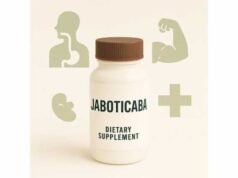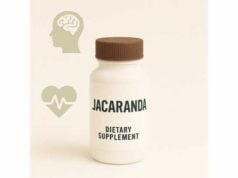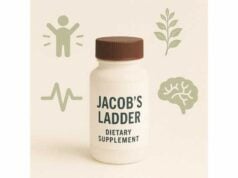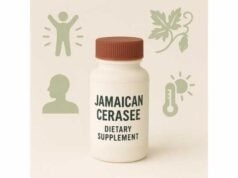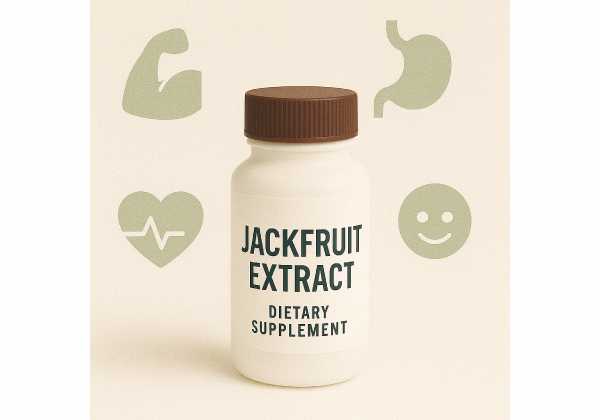
Jackfruit extract is gaining attention for its potential health benefits that extend beyond the fruit’s culinary appeal. Concentrates from the leaf, seed, peel, and unripe pulp contain polyphenols (such as artocarpin and related flavonoids), dietary fiber–associated compounds, and other bioactives that may support healthy blood sugar control, antioxidant defenses, and gut health. In nutrition studies, green jackfruit flour—made from unripe fruit and often used as a functional food—has been linked with modest improvements in glycemic markers when it replaces refined carbohydrates. Extracts from different plant parts have also shown enzyme-modulating and anti-inflammatory activity in experimental research.
In this guide, you will learn what “jackfruit extract” actually includes, where the evidence stands, how to choose a form that fits your goals, and how to use it safely. You will also see where data are preliminary, where whole-food options may be preferable, and who should avoid it. The goal is a clear, practical overview that respects both the promise and the limits of the science.
Quick Facts
- May help moderate post-meal glucose by inhibiting carbohydrate-digesting enzymes.
- Antioxidant polyphenols from leaf and unripe fruit support cellular defense pathways.
- Typical food-based trial used 30 g/day of green jackfruit flour for 12 weeks; supplement extracts vary widely.
- Avoid if you have known latex allergy or previous jackfruit reactions; discuss with your clinician if you use diabetes medications.
Table of Contents
- What is jackfruit extract?
- Proven benefits and mechanisms
- How to use: forms and timing
- How much should you take?
- Side effects and precautions
- Evidence check: what holds up?
What is jackfruit extract?
“Jackfruit extract” is an umbrella term for concentrated preparations made from different parts of the jackfruit plant (Artocarpus heterophyllus). While most people know the fruit for its pulp—sweet when ripe, savory when unripe—extracts can come from the leaf, seed, peel, bark, or the whole unripe fruit. Each part concentrates a slightly different profile of compounds, which is why labels and standardizations matter.
Common sources and what they contain
- Leaf extracts: Typically alcohol- or water-based concentrates rich in polyphenols and flavonoids. Research often highlights compounds such as artocarpin and related prenylated flavonoids that can modulate enzymes involved in carbohydrate metabolism and oxidative stress pathways.
- Unripe fruit (green) extracts and flours: Unripe jackfruit retains resistant starch and polyphenols. When milled into flour or extracted into polyphenol-rich concentrates, it is studied for effects on post-meal glucose by slowing carbohydrate breakdown.
- Seed-derived preparations: Seeds are high in starch and contain lectins and phenolic compounds. Experimental studies have explored their effects on lipid and glucose metabolism, though human data are limited.
- Peel and rind extracts: Often by-products, these are surprisingly rich in antioxidants and α-glucosidase inhibitors in lab models, which may explain interest in upcycling peel into functional ingredients.
Extract vs. flour vs. whole food
It helps to distinguish three product types you might encounter:
- Extracts (capsules/liquids): These are concentrated and standardized (ideally) to specific polyphenols or total phenolics. They’re convenient, but quality varies widely, and human trials using standardized extracts are still sparse.
- Green jackfruit flour: This is a minimally processed functional food from unripe fruit. It’s used as a partial replacement for refined flour in meals. It is not an “extract” but has the most human data for glycemic impact as a food swap.
- Whole fruit (fresh or dried): Nutritious and fiber-rich, but as a whole food it isn’t directly comparable to an extract and can vary by cultivar and ripeness.
What to look for on labels
- Plant part and standardization: “Leaf extract standardized to X% total polyphenols” is more informative than “jackfruit extract.”
- Solvent system: Water vs. hydro-alcoholic can change the profile.
- Testing: Look for third-party assays (e.g., total phenolics) and absence of contaminants (heavy metals, pesticides).
- Clear usage directions: Especially important because there’s no universal clinical dose for extracts yet.
Bottom line: “Jackfruit extract” is not one thing. Decide based on your goal (e.g., post-meal glucose support vs. general antioxidant intake), then choose the plant part and format that match that goal.
Proven benefits and mechanisms
Glycemic control (best human evidence—food-based approach).
When unripe jackfruit flour partially replaces refined carbohydrates in meals, small but statistically significant improvements in glycemic markers have been observed. In adults with type 2 diabetes, a 12-week, randomized, double-blind trial using 30 g/day of green jackfruit flour split between two meals showed a modest reduction in HbA1c alongside reductions in fasting and postprandial glucose compared with a calorie-matched placebo flour. The effect size was modest (about a quarter of a percentage point for HbA1c), but the strategy—swap in a fiber- and polyphenol-rich food for some refined carbs—is nutritionally sound and easy to sustain.
Carbohydrate-digesting enzyme inhibition (mechanistic support).
Extracts from whole green jackfruit and the leaf have repeatedly inhibited α-glucosidase and α-amylase in vitro, enzymes that break down complex carbohydrates into absorbable sugars. Some jackfruit polyphenols also interact with aldose reductase and can slow protein glycation in lab models. Together, these actions can blunt the post-meal glucose rise and reduce glycation-related stressors. These are lab findings, but they dovetail with the human data seen when green jackfruit flour replaces part of a meal.
Antioxidant and anti-inflammatory properties.
Jackfruit extracts (especially peel, leaf, and unripe fruit) are rich in phenolics that scavenge free radicals and upregulate endogenous defense systems in cell and animal studies. Reviews on jackfruit polysaccharides further describe potential immunomodulatory and hepatoprotective actions in preclinical models. These effects are biologically plausible given the fruit’s phenolic and polysaccharide content but need more human trials to confirm clinically meaningful outcomes.
Other exploratory areas.
Early lab work has probed antimicrobial and antiviral activity of jackfruit-derived substances, and cancer-relevant pathways have been explored with specific compounds and lectins. At present, these findings are preclinical and should be viewed as hypothesis-generating rather than as a reason to self-treat.
What this means for you
- If your main interest is post-meal glucose, the most practical, evidence-aligned step is food substitution (e.g., replacing some rice/wheat flour with green jackfruit flour).
- If you prefer capsules or tinctures, choose a product that discloses the plant part and standardization. Expect benefits, if any, to be subtle and to depend on diet quality, meal composition, and consistency over several weeks.
Limitations to keep in mind: human evidence focuses on flour-based substitution, not on high-dose extracts; enzyme-inhibition data come mostly from lab models; and effects likely vary by cultivar, processing, and dose.
How to use: forms and timing
Match the format to your goal
- For meal-time glucose support: Consider green jackfruit flour as a partial swap for refined flour in the meals that drive your biggest glucose spikes (often breakfast and dinner). Practical examples include replacing part of rice or wheat flour in flatbreads, pancakes, or porridges. In the human trial, the daily intake was split across two meals, which mirrors how most people experience their largest glycemic loads.
- For general antioxidant and wellness goals: A leaf or unripe-fruit extract standardized to total polyphenols offers convenience. These are typically taken 1–2 times daily and may be paired with meals to support digestive comfort.
- For culinary and texture benefits: Whole fruit or seed flour can diversify recipes. Seeds add body to baked goods and may contribute resistant starch; however, they’re less studied clinically than unripe pulp flour.
Timing tips
- With carbohydrate-rich meals: If your product target is carbohydrate-digesting enzymes, taking it just before or with the meal is logical. Flour used as an ingredient automatically synchronizes timing.
- Split dosing: For steady exposure without large single doses, split the day’s amount across two meals (morning and evening).
- Consistency over weeks: Glycemic markers such as HbA1c respond over months. Commit to a consistent pattern for at least 8–12 weeks before judging impact, and track with a meter or CGM if available.
Pair with smart meal construction
- Combine the flour or extract with protein, healthy fats, and non-starchy vegetables to slow gastric emptying.
- Prioritize minimally processed carbs overall; an extract cannot fully counteract a high-sugar pattern.
- Consider pre-meal walks or post-meal movement to amplify benefits.
Quality and sourcing checklist
- Transparency: Plant part, extraction solvent, and any standardization (e.g., “≥20% total phenolics”) clearly listed.
- Third-party testing: Look for certificates indicating contaminant screening.
- Sensible serving sizes: Be cautious with products making outsized claims or recommending very high doses without rationale.
- Allergen warnings: If you have latex allergy or a history of fruit-related oral allergy, screen labels carefully and consult your clinician before use.
Finally, remember that extracts complement—not replace—medical care. If you live with diabetes or prediabetes, integrate any jackfruit product into an overall plan that includes diet quality, movement, sleep, and your prescribed therapies.
How much should you take?
Because “jackfruit extract” isn’t a single standardized product, there’s no one clinical dose for all formats. What we do have are food-based trial amounts and practical principles for extracts.
Food-based guidance (best human data)
- Green jackfruit flour: In a 12-week randomized trial, adults with type 2 diabetes used 30 g/day of green jackfruit flour, divided between two meals. It replaced an equal volume of rice or wheat flour (not an add-on). This approach is most relevant if you regularly eat refined flour and want a like-for-like swap that modestly improves glucose handling.
Extract-based practical ranges (limited human data)
When using standardized extracts (leaf or unripe fruit), follow the label and start low. In the absence of robust dose-finding trials, many manufacturers position servings in the range of 250–500 mg per day, sometimes in divided doses. A conservative, stepwise plan looks like this:
- Week 1: 100–250 mg daily with a carbohydrate-containing meal, checking for tolerance.
- Weeks 2–4: If well tolerated and you want a stronger trial, increase to 250–500 mg/day, split with breakfast and dinner.
- Upper bound caution: Without clinical dose-response data, avoid exceeding 1,000 mg/day of concentrated extract unless directed by a clinician who can monitor you.
Special considerations
- Medication use: If you take metformin, sulfonylureas, insulin, or GLP-1/GIP agonists, introduce any extract slowly and track glucose to avoid additive hypoglycemia, especially if meals are smaller.
- Meal composition: Doses have more noticeable effects when paired with starch-heavy meals (e.g., rice, flatbreads, noodles) than with low-carb or protein-dominant meals.
- Body size and sensitivity: Smaller individuals, older adults, and those with variable appetite may do better with the lower end of ranges.
When to reassess
- If you’re not seeing any change after 8–12 weeks of consistent use with appropriate meals—and you’ve also worked on meal quality—consider stopping. Extracts should earn their keep.
Children, pregnancy, and lactation
- There are no established dosages for children, pregnant, or breastfeeding individuals. In these groups, prioritize whole-diet strategies under clinical guidance rather than supplements.
Overall, let food substitution be your first tool, with extracts as optional adjuncts. The safest, evidence-aligned “dose” is the amount of green jackfruit flour that replaces some refined flour in meals you already eat.
Side effects and precautions
Allergy and cross-reactivity
Although uncommon, jackfruit can trigger severe allergic reactions, including anaphylaxis, especially in people with latex allergy (latex-fruit syndrome). Case reports also describe reactions linked to birch-pollen-related cross-reactivity. If you have a history of latex allergy, prior reactions to tropical fruits, or oral allergy symptoms (itching in mouth or throat) with related fruits, do not start jackfruit extract without medical advice. Discontinue immediately if you notice hives, swelling, wheeze, throat tightness, or dizziness.
Gastrointestinal effects
Polyphenol-rich extracts and high-fiber flours can cause bloating, gas, or loose stools, especially if you escalate dose quickly or add them to large, high-carb meals. Start low, split doses, and pair with adequate hydration.
Blood sugar interactions
Because extracts may reduce post-meal glucose, monitor closely if you use insulin or insulin-secretagogues. Adjustments to medication should be made with your clinician, not by guesswork. Consider checking pre- and 2-hour post-meal glucose when introducing the product.
Blood pressure, kidneys, and electrolytes
Jackfruit as a whole food contains potassium. While typical extract servings contribute far less than a full serving of fruit, people with advanced kidney disease or those on potassium-sparing medications should discuss any concentrated plant product with their nephrology team.
Surgery and procedures
Stop non-essential supplements 1–2 weeks before planned procedures. Notify your care team of any extracts you take.
Pregnancy and breastfeeding
There’s insufficient safety data for concentrated jackfruit extracts in pregnancy or lactation. Whole-food forms in normal culinary amounts may be acceptable for some, but discuss any supplement use with your obstetric provider.
Quality and contamination
Choose products that provide third-party testing for microbial load, heavy metals, and adulterants. Avoid products making drug-like claims or offering “megadose” extracts without disclosing standardization.
Who should avoid jackfruit extract
- Anyone with known jackfruit allergy or latex allergy without prior allergist clearance.
- Individuals with unexplained anaphylaxis or complex oral allergy syndrome until formally evaluated.
- Children, pregnant, or breastfeeding individuals unless a clinician advises otherwise.
- People on multiple glucose-lowering medications who cannot monitor regularly or access medication adjustments.
Used thoughtfully, most people tolerate jackfruit flour and modest extract doses well. The priority is to introduce it carefully, monitor, and make safety the first step—not an afterthought.
Evidence check: what holds up?
It’s helpful to separate what’s supported in people from what’s promising in lab models.
Supported in humans (with caveats)
- Glycemic impact via food substitution: In adults with type 2 diabetes, 30 g/day of green jackfruit flour partially replacing rice/wheat flour modestly lowered HbA1c and glucose over 12 weeks compared with a matched placebo flour. This is a reasonable, food-first tactic for people who regularly eat refined grains. Limitations include small sample sizes, short duration, and potential conflicts of interest in some studies. Still, the direction and mechanism are consistent with nutrition fundamentals: more fiber and polyphenols, fewer fast-absorbed carbs.
Mechanistic and preclinical findings
- Enzyme inhibition: Jackfruit polyphenols (from unripe fruit and leaf) inhibit α-glucosidase and α-amylase, aligning with lower post-meal glucose excursions. Some studies also show interactions with aldose reductase and protein glycation pathways.
- Antioxidant and immunomodulatory effects: Leaf, peel, and polysaccharide fractions activate antioxidant defenses and show anti-inflammatory signals in cells and animal models. These actions plausibly contribute to metabolic resilience but require clinical trials to confirm health outcomes.
- Matrix matters: Peel and rind extracts can be particularly rich in phenolics in lab assays, while flour preserves resistant starch that feeds gut microbes and slows glucose absorption. Different parts, different strengths.
Safety signal
- Allergy risk: Published case reports link jackfruit reactions to latex cross-reactivity and possibly birch-related oral allergy. The risk is low for the general population but significant for susceptible individuals. Supplement labels rarely flag this clearly, so allergy-aware screening is essential.
What we still need
- Standardized extract trials: Most human data involve flour substitution, not concentrated extract capsules. Well-designed trials should test standardized leaf or unripe-fruit extracts at practical doses (e.g., 250–500 mg/day) against active comparators and track not only glucose, but also lipids, inflammatory markers, and tolerability.
- Longer durations and diverse diets: Because meal context influences outcomes, trials across different cuisines and carbohydrate patterns would clarify real-world effectiveness.
- Safety in special populations: Data in pregnancy, lactation, chronic kidney disease, and polypharmacy are lacking.
Pragmatic bottom line
- If you’re curious and eat refined grains, start with food substitution using green jackfruit flour at meals where you’d otherwise rely on white rice or refined wheat.
- If you choose a capsule, select a transparent, standardized product, begin at the low end of ranges, and monitor.
- Treat any benefits as adjuncts to the fundamentals: balanced meals, movement, medication adherence, and sleep.
This balanced view respects both the real promise of jackfruit-derived products and the present limitations of the evidence base.
References
- Efficacy of green jackfruit flour as a medical nutrition therapy replacing rice or wheat in patients with type 2 diabetes mellitus: a randomized, double-blind, placebo-controlled study — 2021 (RCT)
- Inhibitory Effect of Polyphenols from the Whole Green Jackfruit Flour against α-Glucosidase, α-Amylase, Aldose Reductase and Glycation at Multiple Stages and Their Interaction: Inhibition Kinetics and Molecular Simulations — 2022
- Jackfruit Anaphylaxis in a Latex Allergic Non-Healthcare Worker — 2021
- Jackfruit Anaphylaxis Due to Cross Reactivity with Latex — 2023
- Recent developments in Artocarpus heterophyllus Lam. (jackfruit) polysaccharides: Nutritional values, structural characteristics and health benefits — 2025 (Systematic Review)
Disclaimer
This article is for informational purposes only and is not a substitute for personalized medical advice, diagnosis, or treatment. Jackfruit extract and green jackfruit flour can affect blood sugar and may interact with medications. Always consult your qualified healthcare professional before starting, stopping, or changing any supplement or nutrition plan, especially if you have a medical condition, are pregnant or breastfeeding, or take prescription drugs.
If you found this guide useful, please consider sharing it on Facebook, X (formerly Twitter), or your preferred platform, and follow us for future evidence-based articles. Your support helps us continue creating reliable, people-first health content.

